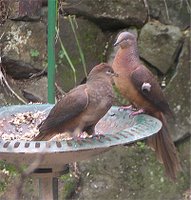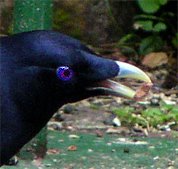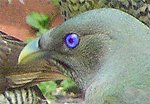I went to have coffee with George, and being conscious that the last time I had gone there, I spent ages taking photographs of birds, I thought it would have been rude of me to do the same today.
Damn this politeness which my parents tried to instill in me.
*****
Brown Cuckoo-Dove
 When I got to George's place, I had to gently walk past the feeding table while 4 "Brown Pigeons" sat there - within metres of me.
When I got to George's place, I had to gently walk past the feeding table while 4 "Brown Pigeons" sat there - within metres of me.No Camera!
George took pity on me, and loaned me his camera, and I took a few photos. Thanks George.
Incidentally, the Brown Pigeon is officially called the Brown Cuckoo-dove (Macropygia phasianella) these days - a truly stupid name. They do have a dove-like long tail, I accept that. But the Cuckoo part is totally misleading. Indeed the Latin specific name would refer to it being "pheasant like" - even more misleading. I suspect the "Cuckoo-dove" name is is due to the internationalistion of bird names - presumably there are related birds in South-east Asia, with the same generic name. (That guess has been confirmed via a later Google search - birds of the same genus are indeed found in Indonesia, Malaysia, etc.) DJW
To explain further, under the rules of nomenclature, the first "valid name" has priority, so however the bird was first described - in a formal taxonomic paper (usually published in scientific Latin, in a European scientific journal), that name sticks, unless some later, smarter taxonomist can prove that the bird is fundamentally different from others which were once all named in the same group. Then, the smart taxonomist can then invent a new name. In the case of Australian birds, early explorers named birds as they found them. Later on, internationalisation came in, and taxonomists said: This bird which you call a Brown Pigeon" is actually in the same genus as these other Asian birds, and their "earlier" name then becomes applied. Of course, in the case of a clunky English name like "Cuckoo-dove" is not likely to be the name by which these birds are known in Asia - it is how they are known in English books of Asian birds. So, it is almost certainly an old name given by a European explorer, or (worse) a taxonomist working away, deep in the bowels of a dusty European Museum looking - at a stuffed specimen sent back to Europe, from Asia. At least the "dove" part of the name is appropriate, but forget the "Cuckoo", (or the "pheasant" - for you Latin speakers). Such is the Nature of Science. DJW.
Satin Bowerbird - female
 There were many Satin Bowerbirds - mostly the ones in the green plumage, which might be females, or immature males. This is a female - you can tell by the dark beak colour. (Photo by George)
There were many Satin Bowerbirds - mostly the ones in the green plumage, which might be females, or immature males. This is a female - you can tell by the dark beak colour. (Photo by George)This explains why one sees far more "green" birds than "blue" - half of the green birds are likely to be immature males, up to the age of about 4 or 5 years old, apparently.
Satin Bowerbird - Male
 Then, a male Satin Bowerbird (the "Blue Bird" as locals call it), flew down to the feeder. Damn! (Photo by George)
Then, a male Satin Bowerbird (the "Blue Bird" as locals call it), flew down to the feeder. Damn! (Photo by George)This bird is the absolute jewel of the local forest. He is so dark blue that, from front on, he looks totally black, except where the light glistens off his head, or wings. He has a real high gloss finish on his feathers. Amazing!
To top it all off, Bowerbirds have this most amazing blue eye, with a tinge of red in it.
Male

female

Immature Male (note beak colour)

White-headed Pigeon
 George also gave me some photos which he had taken previously - this shot of a White-headed Pigeon, and the great shots of the male Satin Bower Bird, and of a female.
George also gave me some photos which he had taken previously - this shot of a White-headed Pigeon, and the great shots of the male Satin Bower Bird, and of a female.So I am sharing these with you today, courtesy of George.

No comments:
Post a Comment